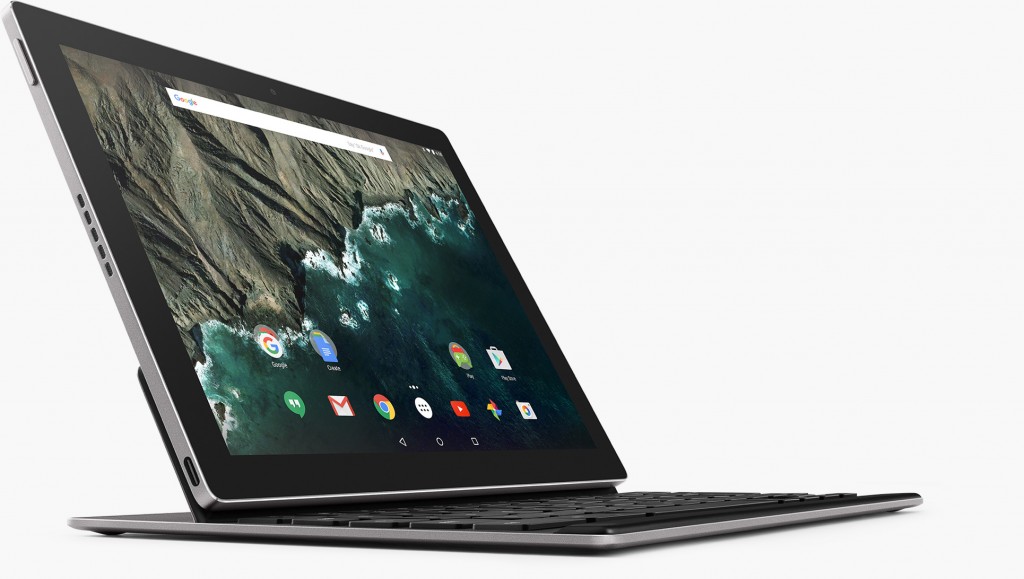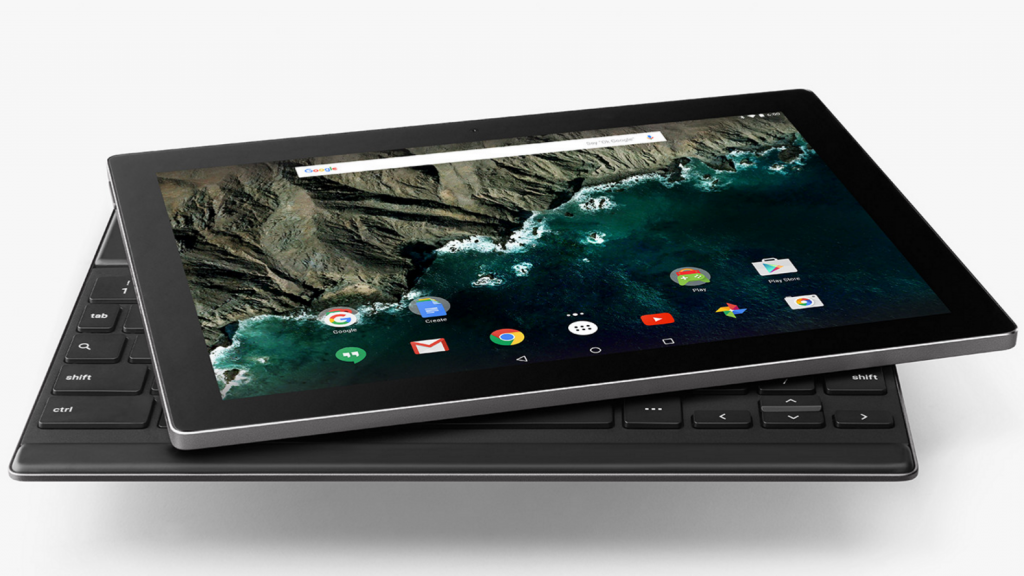The tablet market is a crowded place these days. Samsung and Apple dominate their respective markets and it sometimes seems as if they are the only two options available if you don’t have the cash to spring for a Surface, or simply don’t want a windows tablet. Google, in their infinite wisdom has seen fit to offer us a high end alternative in the Pixel C. However, this tablet sits in an odd spot. Hasving recieved one for Christmas, I’ve been playing around with it for the past 24 hours. So, what do I think?

*Note: This review was written entirely on the Pixel C using the Pixel keyboard.
**Further note due to fussbudget Crimsonshade: All typos the result of the Pixel keyboard and are included for authenticity.
Specs
| Operating System |
Android 6.0 Marshmallow |
| Display |
10.2-inch LTPS LCD,2560×1800 (308 ppi)
500 nit brightness
sRGB color gamut gamut |
| Processor |
NVIDIA Tegra X1
256 core Maxwell GPU |
| RAM |
3GB LPDDR3 |
| Internal storage |
32GB or 64GB |
| Cameras |
2MP front
8MP rear |
| Battery |
34.2 WHr (9243 mAh) |
| Charging |
USB-C |
| Audio |
Stereo speakers
Quad noise-cancelling microphones
3.5 mm audio out |
| Connectivity |
Wi-Fi 802.11 a/b/g/n/ac, 2×2 MIMO, dual-band
Bluetooth 4.1 + HS 4.1 + HS |
| Sensors |
Ambient Light, Gyroscope, Accelerometer, Compass, Hall, Proximity |
| Keyboard |
Optional Bluetooth wireless keyboard |
| Dimensions |
242 x 179 x 7 mm |
| Weight |
0.517 kg / 1.139 lb |
Pixel C keyboard specs
| Key travel |
1.4 mm (full) travel |
| Ergonomics |
Adjustable screen angle: 100 to 135-degrees
Pitch: 18.85 mm (99 percent) |
| Battery |
0.5 WHr |
| Charging |
Inductive charging from Pixel C (no charger or cable required) |
| Connectivity |
Bluetooth LE |
| Dimensions |
242 x 179 x 5.5 mm |
| Weight |
399 g / 0.879 lb |
Theres no doubt that the Pixel C is a powerful piece of hardware. The screen is bright and colorful, playing back video and rendering games such as Tales From The Borderlands in crisp detail with no sign of artifacting. Plentiful RAM means that animations on menus, switching between apps and loading high content webpages is a fast, hassle free experience. Voice is a key part of Android 6.0 Marshmallow and the four microphones located on the top of the Pixel C guarantee that the tablet will hear you loud and clear when you say “Ok Google”. Of course, the cameras are nothing to write home about. The rear facing camera has no flash, meaning you’ll need good lighting if you plan on taking pictures with it. This is further complicated by the unwieldiness of taking pictures with something as large as a tablet. You’ll get better performance out of the camera in your smartphone. Then again, if you are relying on a tablet keyboard for your photography needs, we may need to have a chat. Likewise, the front facing camera is servicable, but please don’t use it for anything but video calling.
The speakers on the Pixel C are crisp and strong. Obivously, you aren’t going to get a ton of bass out of something as small as a tablet speaker, but highs and mids sound crisp without being tinny. Turning them up reveals a truly deafening amount of power for such a small device, and again with little to no distortion. Headphones are obviously the way to go, but if you find yourself without or are sharing a video with friends, the Pixel C’s speakers are great in their own right.
The Keyboard
The Pixel C keyboard gets its own section because its such an integral part of the way Google is marketing the device. The keyboard snaps onto the Pixel via magnets. Very strong magnets. Picking the tablet up and shaking it won’t dislodge the keyboard. It’s rather impressive actually. The magnets allow you to use the Pixel more as a laptop, letting the tablet tilt through a wide range of motion to accomodate being used on a desk or in your lap. I’m currently sitting on my bed with the Pixel in my lap typing this review, and the experience is as comfortable as any I’ve ever had on a high end laptop. Naturally, the keys are a bit more cramped than a traditional keyboard, but thats to be expected on a keyboard of this size. Google has done an admirable job of allowing the keys to travel, giving a good tactile feedback as you type. They’ve also eliminated some keys, opting instead to include a button directly to the right of the spacebar that opens an on screen menu filled with common symbols. Reaching up to the screen to tap these does feel a bit odd and takes some getting used to, but in my opinion it’s worth the extra reach if it gives me an excellent typing experience on a relatively uncluttered keyboard.

The keyboard also doubles as a cover for the Pixel C’s gorgeous screen, and sliding it up and over the tablet is a simple and satisfying proocedure. Similarly, when you want to use the tablet as….just a tablet, simply slide the keyboard around to the back or remove it entirely. The entire process is quick and easy, and makes the Pixel feel like a versatile and robust machine. Its also nice to know that I don’t have to worry about charging the keyboard seperately. The Pixel charges they kehboard inductively, so as long as it’s attached to the body of the tablet, you’ll never have to worry about it’s battery level. And even if you forget, Google promises a staggeringly long battery life for the keyboard.
User Experience
This is one of those hard to quantify categories, but something vital to the review of any piece of hardware. How does it FEEL to use the tablet?
In short: It feels great. The Pixel’s case is sleek and feels high quality. The screen looks fantastic. Apps open quickly, swapping between apps is easy, and gaming is great thanks to the powerful GPU housed inside. Of course, the Pixel sits somewhere between Apple’s pure tablets and the Windows user experience of the Surface. It’s great for browsing the web, playing games and watching YouTube. However, Android doesn’t have a dedicated suite of productivity apps like the Surface does. Of course you can use Google Docs, but thats not quite the same as the full Microsoft Office suite. Another hinderance to getting serious work done on the Pixel C is Android’s lack of multitasking. There is an experimental dual window mode, but in my tests I found it to be extremely buggy. It’s still a work in progress, but for now it leaves the Pixel in a spot where using more than one app at once evokes the tedious experience of opening your app manager and swapping through apps. Its cfertainly doable, but not intuitive or efficient.
The Verdict
The Pixel C is a fantastic piece of hardware. It has some great features, like the powerful speakers and beautiful display. It makes gaming, browsing the web and watching cat videos on YouTube a fast and easy experience. The keyboard is a godsend for those that hate typing emailson a touchscreen. And I must say, I enjoy the ability to tap on the back of the tablet and see the lightbars illuminate to show me how much charge the tablet has without having to unlock the screen. However, the Pixel C sits in an odd spot. It seems Google was thinking for the future, as they often do with products in the Pixel line. Android in it’s current form is severely limiting on the productivity of any power user.
In short, the Pixel C is a great pickup if you simply have to have the most powerful Android tablet available and have the cash to burn. If you are having a light work day, taking it with you is a viable option if you don’t want to lug a laptop around. Still, it has room to grow if Google can only take it in the right direction.





